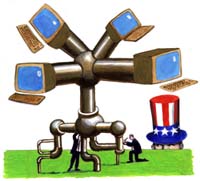As the 20th century draws to a close, there is little doubt that the Internet will go down as one of the period’s crowning achievements, making the growth of other technologies pale in comparison. Radio took more than 30 years to reach 60 million people, while television took some 15 years to reach that mark. In less than five years, however, the Internet has spread to an estimated 90 million people. The Internet has also brought about a new trading category, electronic commerce, which rang up more than $5.1 billion in transactions during 1998, double the activity from the previous year. This growth, however, rests upon the ability of communications networks to transfer huge amounts of graphical and textual data reliably and at high speeds. And that transfer rate rests upon the transmission infrastructure, broadband networking, which actually transmits the Internet’s signals. In a recent paper, Wharton’s Gerald R. Faulhaber and doctoral candidate Christiaan Hogendorn examine the issue of whether free market forces will continue to be capable of providing the broadband networks that underpin the Internet’s growth, or if government regulation will be necessary to keep its development on track. Historically, common carrier networks like telephone and cable systems were assumed to be natural monopolies, in which regions could best be served by a single company that was subject to strict government regulation. It was thought that the economies of scale were so great that a monopoly would be the “natural” outcome of competition, and it was believed that regulation was necessary to achieve universal service, where the new technologies would be available to most, if not all, citizens. But to date, the Internet has been able to avoid government regulation issues (as least regarding transmission facilities), primarily because its signals are carried over existing telephone lines. As demand for faster connections grows, however, new, high-capacity transmission facilities, using telephone, satellite, or cable networks, are being constructed. The rollout will likely involve investments of up to hundreds of billions of dollars, and may be as significant as the deployment of telephone networks in the early part of the 20th century, or that of cable systems in the 1970s and 1980s. Interestingly, the loudest call for government regulation currently originates from an Internet Service Provider (ISP), America Online,which sees a potential threat in telecommunication company AT&T’s acquisition of extensive broadband network facilities that may be dedicated to the company’s own ISP. To consider the broader question of free market growth vs. government regulation of broadband network development, Faulhaber and Hogendorn developed a mathematical model of competition among broadband providers in a hypothetical metropolitan area, using engineering data developed for broadband networks. They address two questions: Is the broadband network market a natural monopoly, in that competition cannot be supported? And would an unregulated market result in all (or most) households having broadband service available (universal service)? While drawing no general conclusions about the desirability of regulation, Faulhaber and Hogendorn focus their study on the underlying economic factors of this market that could determine whether or not economic regulation makes sense. Specifically, they constructed three sub-models, designed to mirror the existing market in varying levels. One model assumes an environment where demand is fixed (this is obviously more theoretical than practical, at least in today’s environment), firms freely decide whether to enter a particular market, and can choose the scope of their network as well as capacity without regard to any regulation. A second model, characterized by the authors as minimally interventionist, also assumes that demand is fixed and firms are free to enter a market, but adds a condition imposed by government
What conclusions did Faulhaber and Hogendorn reach?
Simply stated, their models predict that even without government regulation, competition is likely to emerge in the broadband transmissions market, as long as demand for broadband services is sufficiently large.
In the first model, for example, the construction of broadband networks are projected to be profitable in cities with a high population density as well as those with a low population density, assuming demand rates at least 7% higher than those currently in existence. A second competitor can be expected when demand levels reach 30-40% of US households, and in some cases a third competitor may appear when 70-80% of US households demand broadband connections.
In the second model some demand levels actually result in less competition. But Faulhaber and Hogendorn find this effect is negligible in high-density cities, though larger in low-density cities, and they believe it is not significant enough to disrupt a competitive market.
Finally, under the dynamic model (the one closest to a true free market) the authors find that the first firm in the market will consistently build a larger network than that built under the first two models. Companies do this in order to establish an early presence, which may yield a strategic advantage over later entrants.
Regardless of that advantage, Faulhaber and Hogendorn say that additional companies will continue to enter a particular market in search of long-term growth. This competition, in turn, will tend to increase the level and breadth of services while holding the line, or even reducing rates charged to customers. This leads Faulhaber and Hogendorn to conclude that the goal of universal service at competitive rates can be achieved under a free-market model.



